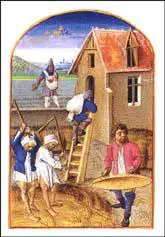Pilgrimage to Canterbury
Soon after the death of Thomas Becket, Pope Alexander canonised him and the murdered priest was elevated to sainthood. Becket's shrine at Canterbury now became the most important place in the country for pilgrims to visit.
When Becket was killed, local people apparently managed to obtain pieces of cloth soaked in his blood. Rumours soon spread that, when touched by this cloth, people were cured of blindness, epilepsy and leprosy. It was not long before the monks at Canterbury Priory were selling small glass bottles of Becket's blood to visitors. The keeper of the shrine would also give the pilgrim a metal badge that had been stamped with the symbol of the shrine.
The monks were afraid that Becket's body might be stolen. To prevent this from happening, Becket's marble coffin was placed in the crypt of the cathedral. The monks also built a stone wall in front of the tomb. There were two gaps in the wall where pilgrims could insert their heads and kiss the tomb.
In 1220, Becket's bones were moved to a new gold-plated and bejewelled shrine behind the high altar. The shrine was placed on a raised platform supported by pillars. Canterbury, because of its religious history, had always seen a large number of pilgrims. However, after the death of Thomas Becket, the number of pilgrims visiting the town grew rapidly.
Diagram of Canterbury Cathedral

Primary Sources
(1) List of some of the relics held at St. Omer's Church in 1346.
A piece of Our Lord's Cross... Pieces of the Lord's tomb... A piece of the Lord's cradle... Some of the hairs of St. Mary. A piece of her robe... Part of St Thomas of Canterbury's tunic. Part of his chair. Shavings from the top of his head. Part of the blanket that covered him, and part of his woollen shirt... part of his hair shirt. Some of his blood.
(2) Benedict of Peterborough described what happened after the death of Thomas Becket. (c. 1175)
Some of the blood was carefully and cleanly collected and poured into a dean vessel and kept in the church.
(3) Gervase of Canterbury, The Deeds of Kings (c.1210)
(Henry II) returned to England (1174)... he set out with a sad heart to the tomb of St. Thomas at Canterbury... he walked barefoot and clad in a woollen smock all the way to the martyr's tomb. There he lay and of his free will was whipped by all the bishops and abbots there present and each individual monk of the church of Canterbury.
